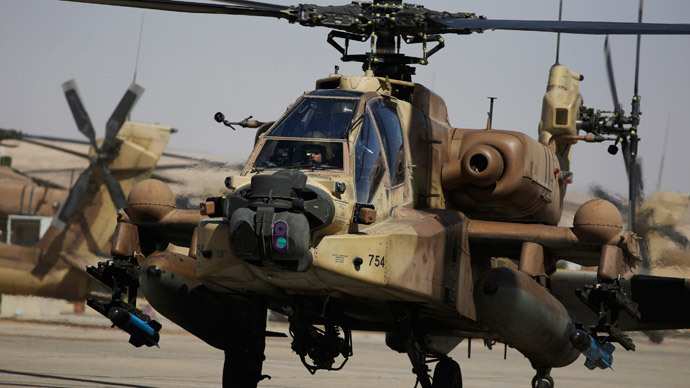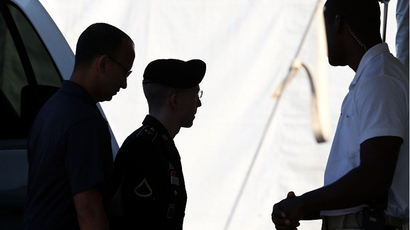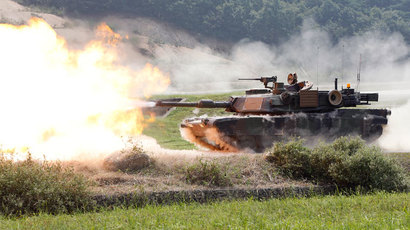Four years after ‘Collateral Murder,’ Lockheed unveils new cameras for Apache helicopters

The United States is outfitting hundreds of armed Apache helicopters with new technology more advanced than what’s available on other rotorcraft, and the Pentagon says the upgrades will allow chopper gunners to strike targets with unmatched accuracy.
Up until now, the Pentagon’s fleet of Apache helicopters was equipped with a system that only allowed crewmembers to see activity on the ground in blurry black-and-white video. On Wednesday this week, though, the US Army unveiled new technology being installed on its AH-64 Apaches that allow those in the cockpit to peer back at the earth from miles off the ground and watch what’s happening in high-definition color.
"This additional situational awareness . . . will give soldiers what they need to make the right decisions on the battlefield," Army Lieutenant Colonel Steven Van Riper — the product manager for the Apache sensors – said at Wednesday’s event, according to Reuters.
Those new capabilities are being made possible specifically due to upgrade on the Apache’s Modernized Target Acquisition Designation Sight/Pilot Night Vision Sensor, or M-TADS/PNVS — the aircraft’s precision targeting and pilotage system.
"We are looking forward to the reliability and maintainability improvements that this laser will bring to the M-TADS system," Van Riper said in a statement this week. "This system will help to further reduce the burden on our aircrews, as they will be able to reap the benefits of the performance improvements."
"The fully modernized M-TADS/PNVS will significantly enhance situational awareness for the Apache crews, and be a decisive factor in the successful execution of their missions," Matt Hoffman, the director of the Apache weapons-system work at developer Lockheed-Martin, said in a prepared statement about the upgrades. In a press release issued this week by the contractor, the upgrades were explained as being able to let Apache pilots see high-resolution, high-definition and color imagery on cockpit displays, while an additional field of view allows them to see civilian and military lighting on a single display more clearly.
Lockheed says they received a $92 million Performance Based Logistics grant from the Army late last year for the sustainment of the M-TADS/PNVS system, and Fox News has reported that the Army wants to retrofit all 680 of their Apache E-models with the new technology as soon as possible.
Some, however — including Reuters — were quick to suggest that Apache upgrades would have been perhaps more appropriate if they were implemented before the US military used those aircraft in deadly, overseas operations, including one in particular that helped raise awareness of America’s role in the Iraq War.
“An Army official said new sensors developed by Lockheed Martin Corp over the past four years,” Reuters’ Andrea Shalal-Esa wrote on Wednesday, “could help avoid mistakes such as the 2007 attack by two US Apache helicopters that killed 12 people in Baghdad, including two Reuters news staff, after they were mistaken for armed insurgents.”
Camera footage recorded from within one of those choppers was later published by anti-secrecy group WikiLeaks under the name “Collateral Murder” after Reuters’ attempts to get information on the incident from the Army proved to be fruitless.
Coincidentally, this Friday marks four-year-to-the-day since Chelsea Manning, a former Army intelligence analyst, uploaded that Apache footage to the WikiLeaks website. According to a statement presented by Manning during pre-trial court proceedings last year, she sent the footage to WikiLeaks “on about 21 February 2010.” It was subsequently edited by WikiLeaks and published online that April, weeks before Manning was arrested on charged with sharing that material and other classified intelligence. She was sentenced to 35 years in prison last August.
“The most alarming aspect of the video to me was the seemingly delightful bloodlust they appeared to have,” Manning recalled of the tape during the statement last January. “They seemed not to value human life by referring to them as ‘dead bastards’ and congratulating each other on the ability to kill in large numbers. At one point in the video there is an individual on the ground attempting to crawl to safety [who] is seriously wounded… For me, this seems similar to a child torturing ants with a magnifying glass.”
“I hoped that the public would be as alarmed as me about the conduct of the aerial weapons team crew members. I wanted the American public to know that not everyone in Iraq and Afghanistan are targets that needed to be neutralized, but rather people who were struggling to live in the pressure cooker environment of what we call asymmetric warfare. After the release I was encouraged by the response in the media and general public, who observed the aerial weapons team video. As I hoped, others were just as troubled-- if not more troubled that me by what they saw,” Manning said.
The US Central Command later admitted that it investigated the incident but had determined that the US forced who fired at civilians and journalists believed the Reuters photographer’s camera was a rocket-propelled grenade launcher.
When the new upgrades are completed, Apache gunners are expected to be less likely to make such mistakes.
"We'll be able to see the red car versus the blue car, or the yellow building versus the green building, whereas before we were totally reliant on being able to communicate either verbally or through tactical text messages," the Army’s Van Riper told reporters this week.
Paul Steele, an Apache pilot, told Alabama TV station WZDX this week that the changes are “something we should have had a long time ago,”
"It's not just the sensor systems and a new display. From the sensor to the display is a major improvement," he said.
Upgrading all 600-plus Apache choppers is expected to take several years. In the meantime, though, Congress on Monday approved a measure that will send six Apaches to Iraq, the first shipment being sent as part of a $4.8 billion deal intended to help battle insurgency in the aftermath of the US war there.














